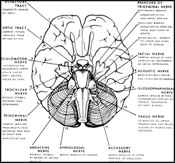Neurological Exam after Concussion
The proper neurological exam after concussion, regardless of what type of physician performs it should also include a detailed history and also a basic test of cognitive function. Perhaps more important, the physical aspect of the exam should should be a diligent, and detailed evaluation. It should include examination of the following parts:
- The movements and reactions of the eye.
- An examination of the eye using an ophthalmoscope.
- A test of smell, of each nostril. This is particularly important in concussion cases, as a compromised sense of smell can be an indicator of frontal lobe damage. Sadly, this is the part of the test most often neglected.
- The patient should be asked to whistle, smile and clench his teeth.
- Hearing should be tested.
- The muscles required to move the head around should be palpitated.
- The patient is asked to do the classic hand and arm movements, in order to elicit evidence of tremors, unilateral or bilateral motor weakness and to evaluate coordination and position sense.
- The neurological exam will also likely contain a rudimentary test of cognitive function, often the mini-mental status exam.
The focus of a neurological exam after concussion is usually the nervous system, with a particular emphasis on the cranial nerves. The Cranial nerves are nerves which branch off of the brain stem, and primarily control the functions which are within the head. The following are the cranial nerves:
- I. Olfactory – Smell. Insist that your neurologist checks this is you have any basis for concern.
- II. Optic – Vision.
- III. Oculomotor – Eye movement.
- IV. Trochlear – Eye movement.
- V. Trigeminal – Controls the muscle and senses of the face.
- VI. Abducens – Eye movement.
- VII. Facial – Taste, expression and facial and scalp movements.
- VIII. Vestibulolocochlear – Hearing and vestibular system.
- IX. Glassopharyngeal – Gag reflex, taste, throat and sinus reflex.
- X. Vagus – throat, voice, gag reflex, coughing, dilations of the stomach.
- XI. Accessory – rotate head, shrug shoulder, raising chin.
- XII. Hypoglossal – muscles of the tongue.

Click Here for a Larger Image: Cranial Nerves